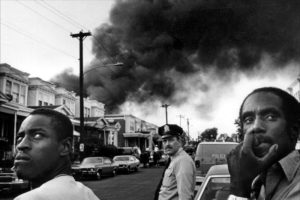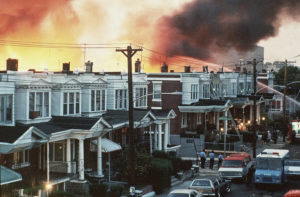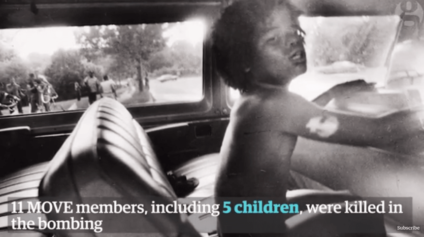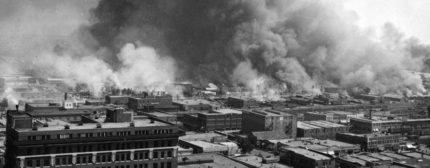
The scene at the corner of 62nd and Larchwood on the afternoon of May 13, 1985, following the dropping of a bomb on MOVE headquarters.
Tom Gralish/Philadelphia Inquirer/MCT/Landov
By David A. Love
Never could one imagine the police doing this in a white neighborhood.
On May 13, 1985, the Philadelphia police engaged in a race riot when they dropped a bomb on the roof of a row house in a Black section of West Philadelphia. It was Mother’s Day, and Black mothers and children were killed that day, intentionally burned and shot to death by police. Eleven people, including five children ages 7 to 13 — all members of the radical Black liberation group MOVE — died.
In the end, 61 homes in this Black residential neighborhood were burned to the ground. Most of all, all of it was done on purpose because the officials in charge said their intent was to let the fire burn.
It had all the makings of a race riot, a lynching. Claiming the MOVE members were a terrorist threat to the community, with automatic weapons and shotguns that did not exist, police with warrant in hand attempted to arrest the MOVE members. Residents of the entire block had been evacuated and told not to return in 24 hours. The water and gas lines were shut off. SWAT teams came rolling in with massive fire power.
After firing a barrage of teargas and water cannons at the MOVE house, police, claiming they had been fired upon by automatic weapons, unloaded 10,000 rounds of ammunition into the house. Finally, police used a state police helicopter to drop four pounds of military-grade C-4 explosives on the roof of the house.
The MOVE Commission, established to investigate the bombing, called the conduct of city officials and the police that day “criminal evil,” and reported that the entire incident would not have occurred “had the MOVE house and its occupants been situated in a comparable white neighborhood.” Further, as attorney Michael Coard wrote in Philadelphia Magazine, although the FBI had stopped sending C-4 to local police departments in 1979, documented records showed that 30 blocks of C-4 were delivered to Philadelphia by an FBI agent in connection with “an anticipated confrontation with MOVE.”
Moreover, the report from the city medical examiner provided proof that six of the 11 people died as a result of gunfire outside the house rather than from the fire inside. There were two survivors, an adult, Ramona Africa, and a child named Birdie Africa, who received a $1.5 million judgment from a federal court. No officials were prosecuted for their misdeeds that day.
As journalist Linn Washington reported, a number of MOVE members tried to escape, and were met with gunfire. “And it was later determined that the police fired on the escaping MOVE members, driving some of them back into the house,” Washington told Democracy Now! Washington echoes the finding of the commission that police gunfire in the rear alley prevented some occupants of the MOVE house from escaping. “But in the convoluted logic that many of us have seen over the last year from grand juries in St. Louis County and in New York and in southern Ohio, where the guy was shot in a Wal-Mart, the grand jury, under the control of Philadelphia prosecutors, determined that MOVE members ran back into the house not because police were firing at them, but because they mistakenly believed that police were firing at them and/or they ran back to intentionally commit suicide,” Washington added.
The bombing of the 6200 block on Osage Avenue in West Philly was the culmination of years of police brutality and corruption in the so-called City of Brotherly Love and Sisterly Affection, which has shown little of either to Black people over the years. Communities of color, and groups such as the Black Panther Party, had endured years of harassment, monitoring and over-policing from law enforcement. As for MOVE, the group had faced a police barricade in 1978, which resulted in the death of a police officer — reportedly by police gunfire — and murder and conspiracy convictions for nine MOVE members. They received sentences ranging between 30 and 100 years, and remain in prison to this day. Some police officers involved in the 1978 incident, including the beating of a MOVE member, purportedly participated in the 1985 operation as an act of revenge.

Flames shoot skyward at the MOVE compound in West Philadelphia on May 13, 1985.
J. Scott Applewhite/AP
In this 21st century reality of police violence emanating from Ferguson, Baltimore, North Charleston and everywhere else, the 1985 police burning of West Philly demands our attention, and reminds us of the intractability of the problems the Black community faces.
And yet, we know this was not the first time a Black community was destroyed by an aerial bombing.
In 1921, amid rumors that a Black man attacked a white woman, a white lynch mob led by the Klan descended upon the African-American community of Tulsa, Oklahoma — known as Greenwood, or Black Wall Street — and destroyed everything. World War I airplanes dropped bombs on the prosperous Black community. Hundreds, perhaps more, were killed, while 10,000 were left homeless, and 35 square blocks and 600 businesses were destroyed. The Oklahoma National Guard was called in, and Black people were placed in detention camps. This was the heyday of race riots and lynchings, when whites were resentful of Black progress, and responded with ethnic cleansing.
So, when we look at the MOVE bombing and ask how this happened, how the murder of innocent women, children and men was allowed to occur without punishment, we must understand that the nation has had a great deal of practice with these things.
As Martin Luther King reminds us even in death, America is plagued by the evil triplets of racism, militarism and economic exploitation. Further, as we bear witness to the protest and unrest that unfold with each subsequent act of police violence, detractors will focus on rioters and looters rather than the systemic conditions that led to the unrest. We can look back to a day 30 years ago, when police waged a race riot against a Black neighborhood and burned it down.




